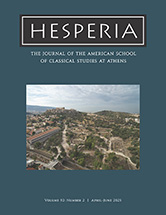Hesperia 92.2 Now Online!

We are pleased to announce the publication of Hesperia 92.2! Topics in this issue include an overview of the commemorative portraiture program in the Athenian Agora from the time of Kleisthenes through Augustus, Classical and Hellenistic curse tablets from the Athenian Agora, and the latest report from the Corinth Excavations.
Subscribers can read the issue online at Project MUSE, which now hosts current issues of Hesperia as well as an archive of past volumes dating to 2002. Hesperia remains on JSTOR as part of their Arts and Sciences II package, with the usual three-year moving wall. Additionally, all issues of Hesperia from 2011 and earlier are available as Open Access on our website. The printed version will be mailed shortly.
“Memorials of All Our Noble Deeds”: Politics, Power, and Representation in the Athenian Agora, 510 B.C. to A.D. 14. A Critical Review, by Andrew Stewart, represents the twelfth and last of a series presented in this journal, offering an overview of the officially commissioned sculptures and paintings in the Athenian Agora from Kleisthenes through Augustus (ca. 510 B.C. to A.D. 14). It also offers new dates and interpretations for some of them, synthesizing the results of work done in the Agora from 2007 to 2019 with the evidence of the written sources. Three appendices present a gazetteer of the sculptures and paintings on and in the Agora’s public buildings, its state-sponsored honorific portraits, and the freestanding statues of the gods there.
Classical and Hellenistic Curse Tablets from the Athenian Agora, by Jaime Curbera and Jessica L. Lamont, publishes 25 lead tablets recovered during systematic excavations of the Athenian Agora, 24 of which were inscribed with curses. All objects date from the 4th century B.C. and emerged in three discrete contexts: beneath the Tholos, in the southern Industrial District, and in the well beside the so-called Crossroads Enclosure. These tablets expand and complicate our understanding of Athenian curse-writing rituals during the Late Classical and Early Hellenistic periods, while shedding new light on onomastics, prosopography, ritual space, and social history in 4th-century Athens.
Corinth, 2020 and 2021: Northeast of the Theater, by Christopher A. Pfaff, presents the report of the 2020 and 2021 excavation seasons at Corinth, which continued the exploration of an area in the southern third of the field northeast of the Theater. Among the results of these two seasons were the discoveries of a Roman road running northward from the paved plaza northeast of the Theater and of a sumptuous Roman room lined with marble-veneered benches and paved with an opus sectile floor. The excavations also brought to light more evidence of the Byzantine road that succeeded the Roman cardo and slight remains of other Byzantine structures, including a small circular structure, perhaps an oven.
Click here to subscribe to Hesperia. In addition to receiving printed issues and online access to Hesperia, subscribers also receive complimentary online access to Hesperia Supplements, and Agora and Corinth volumes.
Hesperia welcomes submissions from scholars working on all aspects of Greek material culture, including archaeology, art, architecture, history, epigraphy, and related studies. Further information about the journal, including instructions for preparing manuscripts for submission, can be found on our website.
The Friends of Hesperia was founded in 2014 to help fund the journal's growth in all its manifestations. We invite you to become a member today and help support one of the most preeminent journals in the field of Mediterranean archaeology.